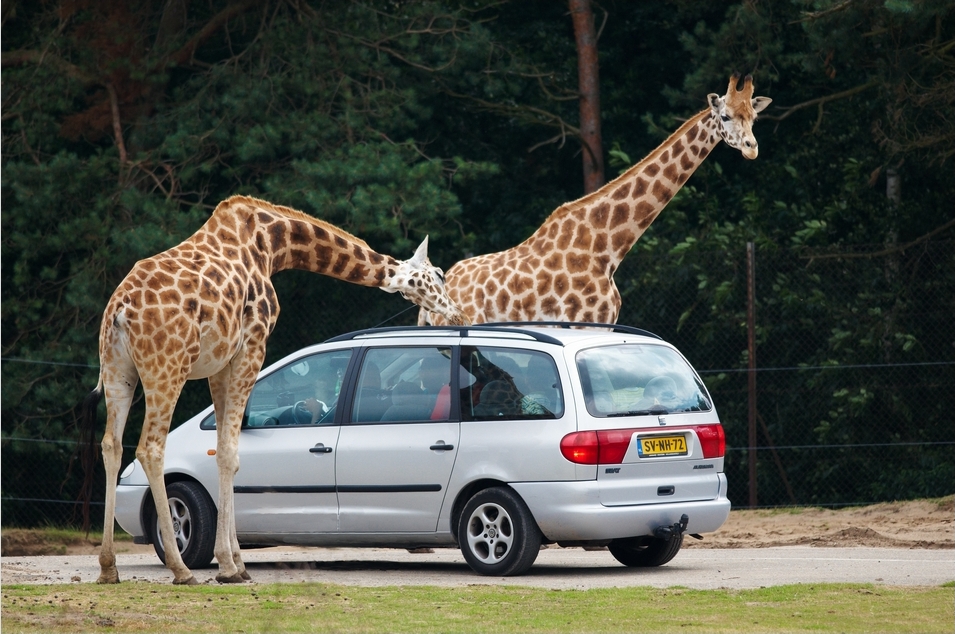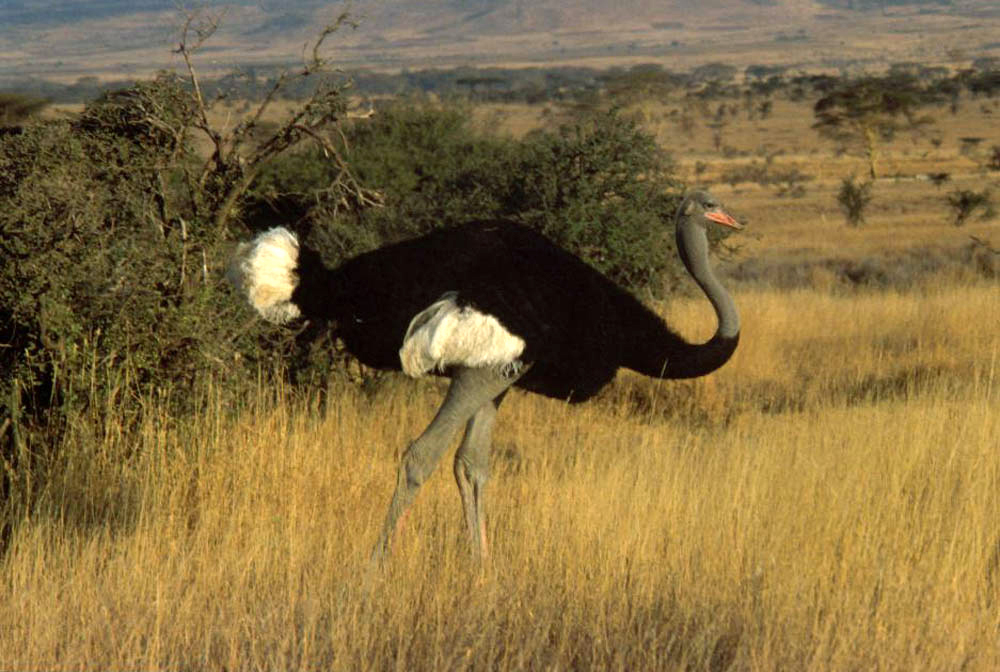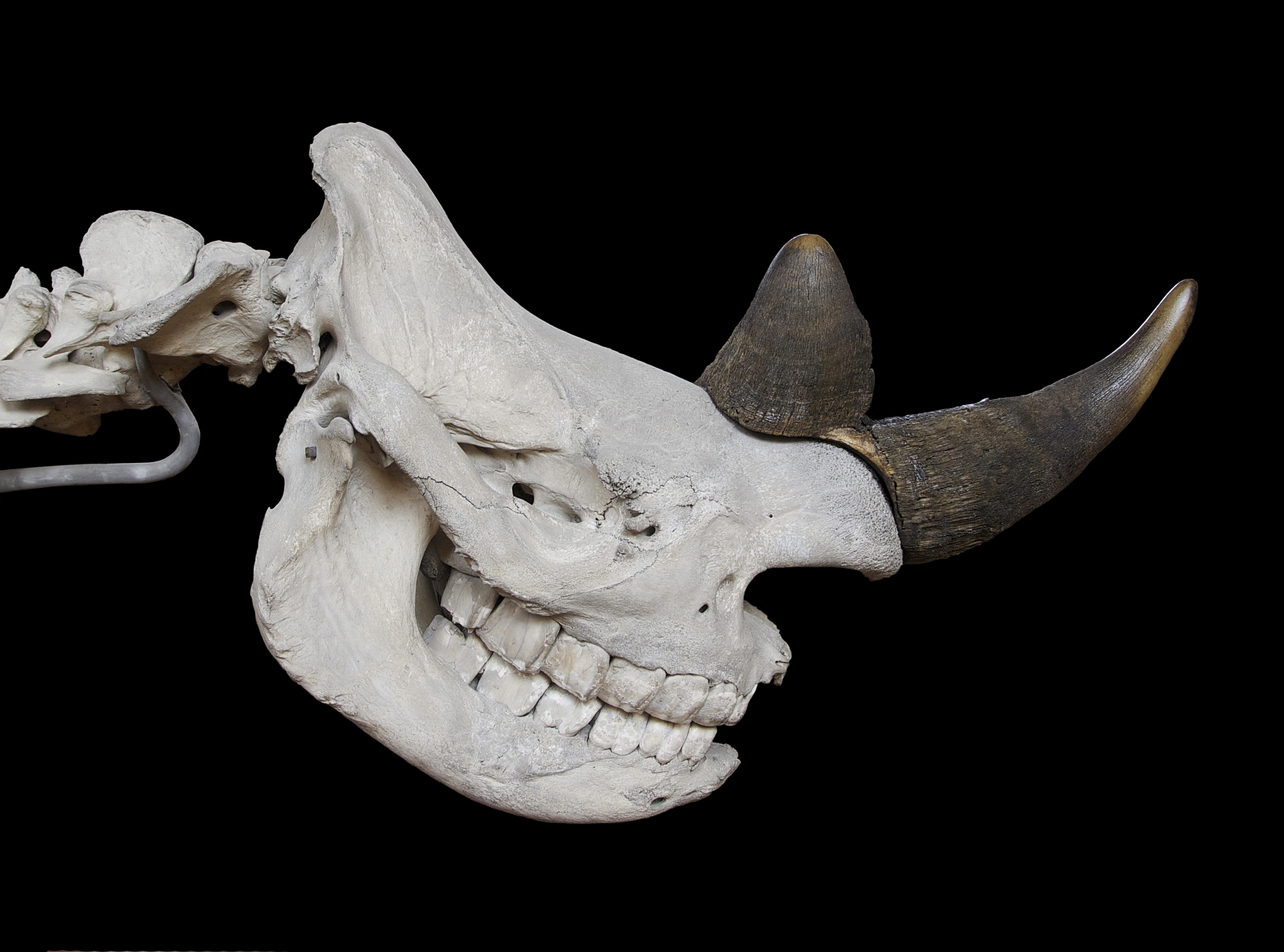|
Safari Parks
A safari park, sometimes known as a wildlife park, is a zoo-like commercial drive-in tourist attraction where visitors can drive their own vehicles or ride in vehicles provided by the facility to observe freely roaming animals. A safari park is larger than a zoo and smaller than a game reserve. For example, African Lion Safari in Hamilton, Ontario, Canada is . For comparison, Lake Nakuru in the Great Rift Valley, Kenya, is , and a typical large game reserve is Tsavo East, also in Kenya, which encompasses . Many parks have conservation programmes with endangered animals like: elephants, rhinocerotes, giraffes, lions, tigers, cheetahs and wild dogs. General overview of a safari park The main attractions are frequently large animals from Africa which people can see in wildlife reserves such as: giraffes, lions (including white lions), black and white rhinoceroses, African bush elephants, hippopotamuses, zebras, ostriches, lesser and greater flamingos, ground hornbills, gui ... [...More Info...] [...Related Items...] OR: [Wikipedia] [Google] [Baidu] |
Giraffa Camelopardalis -Safaripark Beekse Bergen-11July2009
The giraffe is a large African even-toed ungulate, hoofed mammal belonging to the genus ''Giraffa''. It is the Largest mammals#Even-toed Ungulates (Artiodactyla), tallest living terrestrial animal and the largest ruminant on Earth. Traditionally, giraffes were thought to be one species, ''Giraffa camelopardalis'', with nine subspecies. Most recently, researchers proposed dividing them into up to eight Neontology#Extant taxa versus extinct taxa, extant species due to new research into their Mitochondrial DNA, mitochondrial and nuclear DNA, as well as morphological measurements. Seven other extinct species of ''Giraffa'' are known from the fossil record. The giraffe's chief distinguishing characteristics are its extremely long neck and legs, its horn-like ossicones, and its spotted Animal coat, coat patterns. It is classified under the Family (biology), family Giraffidae, along with its closest extant relative, the okapi. Its scattered range extends from Chad in the north to Sou ... [...More Info...] [...Related Items...] OR: [Wikipedia] [Google] [Baidu] |
Tiger
The tiger (''Panthera tigris'') is the largest living cat species and a member of the genus '' Panthera''. It is most recognisable for its dark vertical stripes on orange fur with a white underside. An apex predator, it primarily preys on ungulates, such as deer and wild boar. It is territorial and generally a solitary but social predator, requiring large contiguous areas of habitat to support its requirements for prey and rearing of its offspring. Tiger cubs stay with their mother for about two years and then become independent, leaving their mother's home range to establish their own. The tiger was first scientifically described in 1758. It once ranged widely from the Eastern Anatolia Region in the west to the Amur River basin in the east, and in the south from the foothills of the Himalayas to Bali in the Sunda Islands. Since the early 20th century, tiger populations have lost at least 93% of their historic range and have been extirpated from Western and Central Asia, t ... [...More Info...] [...Related Items...] OR: [Wikipedia] [Google] [Baidu] |
Ground Hornbill
The ground hornbills (Bucorvidae) are a family of the order Bucerotiformes, with a single genus ''Bucorvus'' and two extant species. The family is endemic to sub-Saharan Africa: the Abyssinian ground hornbill occurs in a belt from Senegal east to Ethiopia, and the southern ground hornbill occurs in southern and East Africa. Ground hornbills are large, with adults around a metre tall. Both species are ground-dwelling, unlike other hornbills. Also unlike most other hornbills, they are carnivorous and feed on insects, snakes, other birds, amphibians and even tortoises.Kinnaird Margaret F. and O‘Brien< Timothy G.; ''The Ecology and Conservation of Asian Hornbills: Farmers of the Forest''; pp. 20-23. They are among the longest-lived of all birds, and the larger southern species is possibly the slowest-breeding (triennially) and longest-lived of all birds. Taxonomy The genus ''Bucorvus'' was introduced, originally as a subgenus, by the French naturalist[...More Info...] [...Related Items...] OR: [Wikipedia] [Google] [Baidu] |
Greater Flamingo
The greater flamingo (''Phoenicopterus roseus'') is the most widespread and largest species of the flamingo family. It is found in Africa, the Indian subcontinent, the Middle East, and in southern Europe. Taxonomy The greater flamingo was described by Peter Simon Pallas in 1811. It was previously thought to be the same species as the American flamingo (''Phoenicopterus ruber''), but because of coloring differences of its head, neck, body, and bill, the two flamingos are now most commonly considered separate species. The greater flamingo has no subspecies. Description The greater flamingo is the largest living species of flamingo, averaging tall and weighing . The largest male flamingos have been recorded at up to tall and . Most of the plumage is pinkish-white, but the wing coverts are red and the primary and secondary flight feathers are black. The bill is pink with a restricted black tip, and the legs are entirely pink. The call is a goose-like honking. Chicks are cover ... [...More Info...] [...Related Items...] OR: [Wikipedia] [Google] [Baidu] |
Lesser Flamingo
The lesser flamingo (''Phoeniconaias minor'') is a species of flamingo occurring in sub-Saharan Africa and western India. Birds are occasionally reported from further north, but these are generally considered Vagrancy (biology), vagrants. Characteristics The lesser flamingo is the smallest species of flamingo, though it is a tall and large bird by most standards. The species can weigh from . The standing height is around . The total length (from beak to tail) and wingspan are in the same range of measurements, from . Most of the plumage is pinkish white. The clearest difference between this species and the greater flamingo, the only other Old World species of flamingo, is the much more extensive black on the bill. Size is less helpful unless the species are together, since the sexes of each species also differ in height. The extinct species ''Phoeniconaias proeses'' in the same genus, from the Pliocene of Australia, is thought to have been even smaller. The lesser flamingo may ... [...More Info...] [...Related Items...] OR: [Wikipedia] [Google] [Baidu] |
Ostrich
Ostriches are large flightless birds of the genus ''Struthio'' in the order Struthioniformes, part of the infra-class Palaeognathae, a diverse group of flightless birds also known as ratites that includes the emus, rheas, and kiwis. There are two living species of ostrich: the common ostrich, native to large areas of sub-Saharan Africa and the Somali ostrich, native to the Horn of Africa. The common ostrich was also historically native to the Arabian Peninsula, and ostriches were present across Asia as far east as Mongolia during the Late Pleistocene and possibly into the Holocene. They lay the largest eggs of any living land animal. With the ability to run at 70 km/h (43.5 mph), they are the fastest birds on land. They are farmed worldwide, particularly for their feathers as they are used as decoration and feather dusters. Their skin is also used for leather products. They are the heaviest living birds. Taxonomic history The genus ''Struthio'' was first described b ... [...More Info...] [...Related Items...] OR: [Wikipedia] [Google] [Baidu] |
Zebra
Zebras (, ) (subgenus ''Hippotigris'') are African equines with distinctive black-and-white striped coats. There are three living species: the Grévy's zebra (''Equus grevyi''), plains zebra (''E. quagga''), and the mountain zebra (''E. zebra''). Zebras share the genus ''Equus'' with horses and asses, the three groups being the only living members of the family Equidae. Zebra stripes come in different patterns, unique to each individual. Several theories have been proposed for the function of these stripes, with most evidence supporting them as a deterrent for biting flies. Zebras inhabit eastern and southern Africa and can be found in a variety of habitats such as savannahs, grasslands, woodlands, shrublands, and mountainous areas. Zebras are primarily grazers and can subsist on lower-quality vegetation. They are preyed on mainly by lions, and typically flee when threatened but also bite and kick. Zebra species differ in social behaviour, with plains and mountain zebra ... [...More Info...] [...Related Items...] OR: [Wikipedia] [Google] [Baidu] |
Hippopotamus
The hippopotamus ( ; : hippopotamuses or hippopotami; ''Hippopotamus amphibius''), also called the hippo, common hippopotamus, or river hippopotamus, is a large semiaquatic mammal native to sub-Saharan Africa. It is one of only two extant species in the family Hippopotamidae, the other being the pygmy hippopotamus (''Choeropsis liberiensis'' or ''Hexaprotodon liberiensis''). Its name comes from the ancient Greek for "river horse" (). Aside from elephants and rhinos, the hippopotamus is the largest land mammal. It is also the largest extant land artiodactyl. Despite their physical resemblance to pigs and other terrestrial even-toed ungulates, the closest living relatives of the hippopotamids are cetaceans (whales, dolphins, porpoises, etc.), from which they diverged about 55 million years ago. Hippos are recognisable for their barrel-shaped torsos, wide-opening mouths with large canine tusks, nearly hairless bodies, pillar-like legs, and large size: adults average ... [...More Info...] [...Related Items...] OR: [Wikipedia] [Google] [Baidu] |
African Bush Elephant
The African bush elephant (''Loxodonta africana'') is one of two extant African elephant species and one of three extant elephant species. It is the largest living terrestrial animal, with bulls reaching a shoulder height of up to and a body mass of up to . It is distributed across 37 African countries and inhabits forests, grasslands and woodlands, wetlands and agricultural land. Since 2021, it has been listed as Endangered on the IUCN Red List. It is threatened foremost by habitat destruction, and in parts of its range also by poaching for meat and ivory. It is a social mammal, travelling in herds composed of cows and their offspring. Adult bulls usually live alone or in small bachelor groups. It is a herbivore, feeding on grasses, creepers, herbs, leaves, and bark. The menstrual cycle lasts three to four months, and females are pregnant for 22 months, the longest gestation period of any mammal. Taxonomy ''Elephas africanus'' was the scientific name proposed by Johann Fri ... [...More Info...] [...Related Items...] OR: [Wikipedia] [Google] [Baidu] |
White Rhinoceros
The white rhinoceros, white rhino or square-lipped rhinoceros (''Ceratotherium simum'') is the largest extant species of rhinoceros. It has a wide mouth used for grazing (behaviour), grazing and is the most social of all rhino species. The white rhinoceros consists of two subspecies: the southern white rhinoceros, with an estimated 19,682–21,077 wild-living animals in the year 2015, and the much rarer northern white rhinoceros. The northern subspecies has very few remaining individuals, with only two confirmed left in 2018 (two females: Fatu, 18 and Najin, 29), both in captivity. Sudan (rhinoceros), Sudan, the world's last known male Northern white rhinoceros, died in Kenya on 19 March 2018 at age 45. Naming A popular albeit widely discredited theory of the origins of the name "white rhinoceros" is a mistranslation from Dutch to English. The English word "white" is said to have been derived by mistranslation of the Dutch word "wijd", which means "wide" in English. The word " ... [...More Info...] [...Related Items...] OR: [Wikipedia] [Google] [Baidu] |
Black Rhinoceros
The black rhinoceros, black rhino or hook-lipped rhinoceros (''Diceros bicornis'') is a species of rhinoceros, native to eastern and southern Africa including Angola, Botswana, Kenya, Malawi, Mozambique, Namibia, South Africa, Eswatini, Tanzania, Zambia, and Zimbabwe. Although the rhinoceros is referred to as ''black'', its colours vary from brown to grey. The other African rhinoceros is the white rhinoceros (''Ceratotherium simum''). The word "white" in the name "white rhinoceros" is often said to be a misinterpretation of the Afrikaans word ' (Dutch ') meaning wide, referring to its square upper lip, as opposed to the pointed or hooked lip of the black rhinoceros. These species are now sometimes referred to as the square-lipped (for white) or hook-lipped (for black) rhinoceros. The species overall is classified as critically endangered (even though the south-western black rhinoceros is classified as near threatened). Three subspecies have been declared extinct, including the ... [...More Info...] [...Related Items...] OR: [Wikipedia] [Google] [Baidu] |
White Lion
The white lion is a rare color mutation of the lion, specifically the Southern African lion. White lions in the area of Timbavati are thought to have been indigenous to the Timbavati region of South Africa for centuries, although the earliest recorded sighting in this region was in 1938. White lions first became known to the English-speaking world in 1977 through the book ''The White Lions of Timbavati''. Description White lions are not albinos. Their white color is caused by a recessive trait, called leucism, derived from a less-severe mutation in the same gene that causes albinism, similar to the gene responsible for white tigers. They vary from blonde to near-white. This coloration does not appear to pose a disadvantage to their survival. White lions were considered to have been technically extinct in the wild between 1992 and 2004, when the Global White Lion Protection Trust achieved the first successful reintroduction of white lions to their natural habitat. These prides ha ... [...More Info...] [...Related Items...] OR: [Wikipedia] [Google] [Baidu] |






_03.jpg)


.jpg)